Species List Click on the images for the photographs
Solidobalanus fallax Megatrema anglicum
|
Class
CIRRIPEDIA
|
||
|
|
Order
THORACICA
|
|
|
|
Suborder
LEPADOMORPHA
|
|
|
|
|
Family
Scalpellidae
|
|
|
|
Family
Lepadidae
|
|
|
Suborder
VERRUCOMORPHA
|
|
|
|
|
Family
Verrucidae
|
|
|
Suborder
BALANOMORPHA
|
|
|
|
Superfamily
CHTHAMALOIDEA
|
|
|
|
|
Family
Chthamalidae
|
|
|
Superfamily
CORONULOIDEA
|
|
|
|
|
Family
Coronulidae
|
|
|
Superfamily
BALANOIDEA
|
|
|
|
|
Family
Tetraclitidae
|
|
|
|
Family
Archaeobalanidae
|
|
|
|
Family
Balanidae
|
|
|
|
Family
Pyrgomatidae
|
Species List Click on the images for the photographs
Solidobalanus fallax Megatrema anglicum
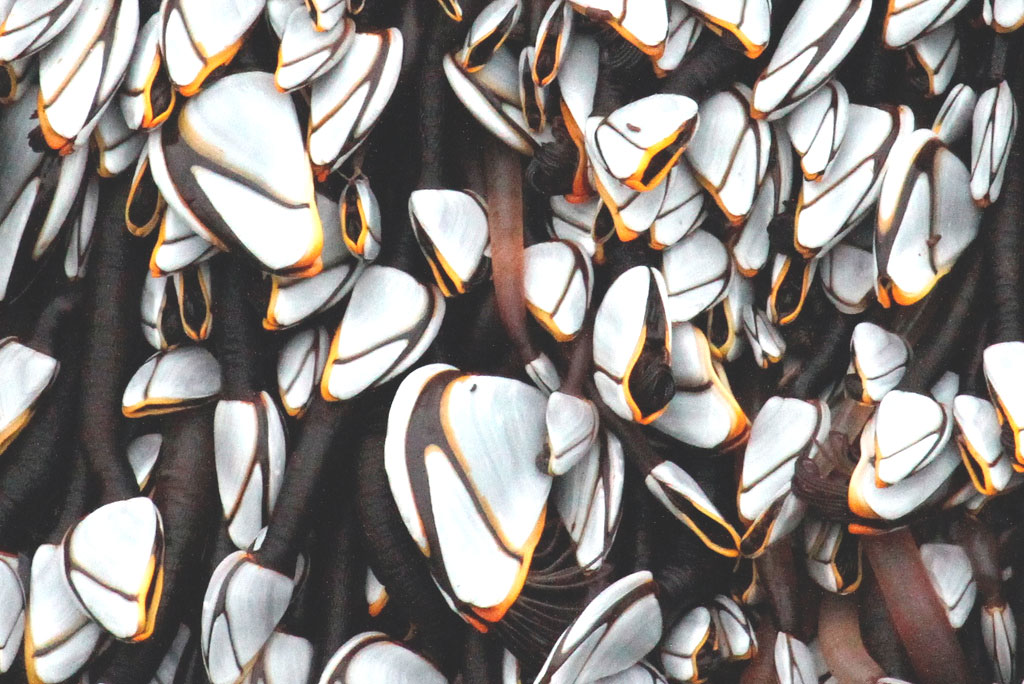
Goose Barnacles
Photograph
by Graham Etherington
October 2010, Isles of Scilly
14 November 2018
Amongst the debris washed ashore on Chesil Beach, Dorset, included Goose Barnacles, Lepas anserifera, Lepas pectinata andLepas hilli, and the rarer pelagic species Concoderma virgatum.
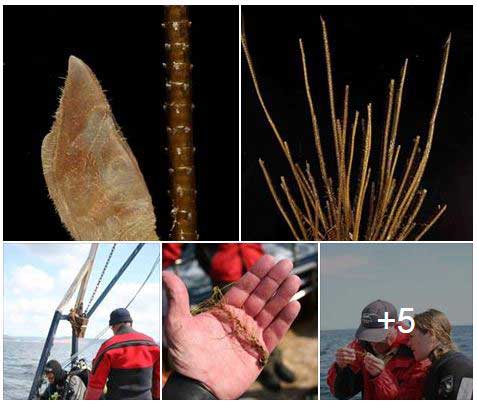 28
December 2015
28
December 2015
 |
Thousands
of clumps of Goose Barnacles,
Lepas
anatifera, attached to floating objects
have been washed ashore all along the south coast from Cornwall to Kent.
Those strandings occur very year, but it seems
that more than the usual number were discovered this winter. Diligent beachcombers
have discovered the tiny Columbus Crabs,
Planes
minutus. amongst the wrecks, as well
as few of the other pelagic
Goose Barnacles like Lepas
anserifera.
Stalked
Barnacles on Aphotomarine (by Dave Fenwick)
Barnacles
at Aphotomarine
Goose
Barnacles on Space Rocket
Photograph
by Tresco Boatman
A large part of a space rocket floated across the Atlantic Ocean from Florida and acquired a large colony of Goose Barnacles, Lepas anatifera, on its one year journey. It eventually beached on Tresco, Isles of Scilly, with the assistance of local fishermen..
9
November 2014
The
pelagic
Striped Goose Barnacle,
Conchoderma
virgatum, was spotted washed ashore
on the Dorset coast. This is only the second known and recorded discovery
of this species on the English coast.
| 22
October 2013
Another fishbox found at Marazion, south Cornwall, had a liberal covering of the live stalked barnacle Lepas pectinata. I find quite a lot of these and they're a very common find at the right time of the year, and can be found on many types of objects washed ashore, from macroalgae, feathers, bottles, margarine containers and workman's helmets. The species is quite variable in its sculpturing and is noted to be white or bluish. Indeed a few of the specimens on the fishbox had a bluish sheen, and it's the first time I've seen this. Report
by David Fenwick
Snr on Porcupine
Society facebook
|
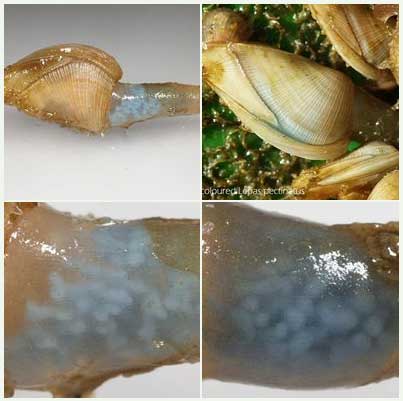 |
15
December 2011
An
interesting large piece of wood was washed up on the strandline at after
storms on low tide at Sennen Cove,
Cornwall: it was completely covered in small to medium sized Goose
Barnacles,
Lepas anatifera.
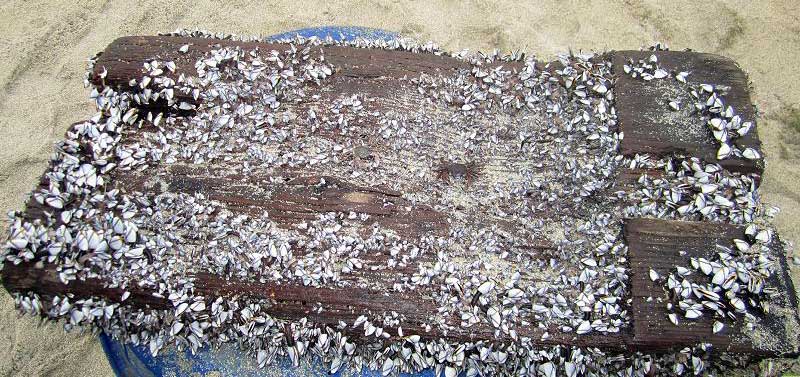
On closer examination it was found to have a cavity at one end and tucked into this was a male and a female Columbus Crab, Planes minutus. Small 3-4 mm egg masses and shipworm holes were also seen which included the rarely recorded Bankia gouldi; as well as Teredora malleolus, which made up about 95% of the shipworms in the timber. Under a magnifying glass and discovered a rare 14 mm pelagic sea slug, Fiona pinnata, which has only been recorded a few times in British seas.
10
October 2011
 |
 |
Goose
Barnacles washed up at Constantine
Bay, near Padstow,
Cornwall
Photographs
by Dave Emott
8 October
2011
I
found three Portuguese Man-o'-War, Physalia
physalis, loads of By-the-Wind Sailors, Velella
velella,
Buoy
Barnacles,
Dosima fascicularis,
and Goose Barnacles, Lepas anatifera,
at Sennen Cove and
Gwynver
Beach, Cornwall.
18
September 2011
Lots
of Buoy Barnacles, Dosima
faciculalaria, now turning up at Sennen
Cove, Cornwall, on feathers, string and more commonly Egg
Wrack, Ascophyllum nodosum. Also
on the Egg Wrack is plenty of Lepas
pectinatus, sometimes both species
together. One or two old Lepas anatifera
and a few large By the Wind Sailors, Velella,
also found today.
10
May 2011
Two
rarely recorded warm water species of barnacle have been discovered on
fishing pots tackle off the coast of Guernsey in the Channel Islands. The
Stalked
Barnacle, Scalpellum
scalpellum, was last recorded
in 1862 although a specimen was found in 2003.
The other species was an Acorn Barnacle, Solidobalanus
fallax, (identified
by Dr. Paul Chambers from Jersey) which was
previously recorded off Plymouth.
27
November 2010
Yet
more Stalked Barnacles
today found east of Marazion,
Cornwall, three lots; Lepas pectinata
was found on a bucket ''Made in Canada''. The most unusual find was Lepas
pectinata along with Sea Lettuce in a
small M&S margarine container.
19
November 2010
Yet
more Stalked Barnacles
found today at Long Rock,
Penzance, this time Lepas pectinata
and Lepas anatifera
on a miniature whisky bottle. Sadly the bottle was empty. A solitary mature
By
the Wind Sailor was also found.
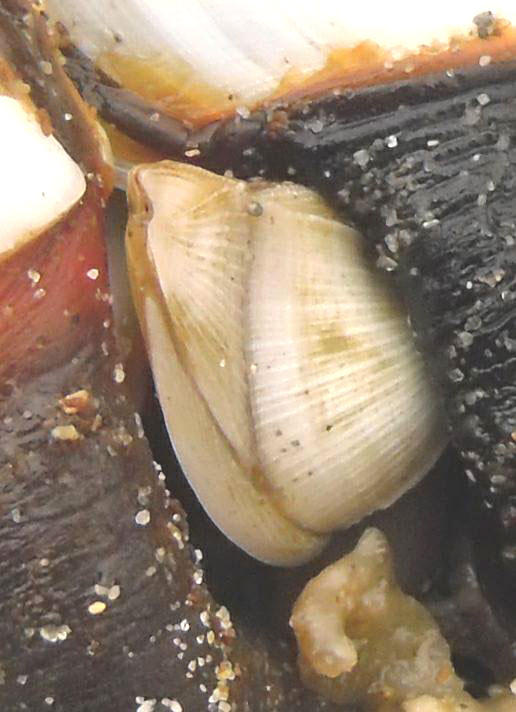 |
3
November 2010
At least three species of Stalked Barnacles, Lepas hilli, Lepas pectinata and Lepas anatifera were discovered on the high tide mark at Long Rock, Penzance, Cornwall. Strong south-westerly winds had washed ashore a large plastic lid that the animals were attached to. This is a pelagic tropical-sub-tropical species that is blown to the UK shores on flotsam via the Gulf Stream. British seas are too cold for these species to survive and breed. Report
and Photograph by Dave Fenwick
Barnacles at Aphotomarine |
|
|
|
| >
24 December 2009
Strong south-westerly winds have blown many organisms on to Dorset beaches including the unusual pelagic Striped Goose Barnacle, Conchoderma virgatum. BMLSS Strandline Reports Photographby Steve Trewhella (facebook) November
2009
|
 |
 |
28
October 2009
Commercial crab and lobster fisherman Clive Brown found what looked like a block of wood covered in Goose Barnacles, Lepas anatifera, floating off the south coast of Guernsey. When he retrieved the bulky mass of Goose Barnacles he found they were covering a piece of communication equipment. The image shows the equipment after 20 kg of the Goose Barnacles had been removed. Four Columbus Crabs, Planes minutus, were also discovered. |
 |
20
September 2008
These large acorn barnacles were seen on rocks along side the Newhaven Harbour Arm, East Sussex. I think they are Balanus perforatus. This is a southern species that is found on the coasts of Devon and Cornwall and not usually recorded east of the Isle of Wight. Report
by Dr Gerald Legg (Booth
Museum)
|
June 2007

What
is this strange animal found on Wembury
beach, near Plymouth,
in
?
Photograph
by Deborah Latham
Buoy
Barnacle, Dosima fascicularis.
ID
by Emma Rance
on
the Marine Wildlife
of the North-east Atlantic Ocean Yahoo Group
17
December 2006
Several
hundred Goose Barnacles, Lepas anatifera,
were washed up near River Road, Littlehampton,
Sussex, after the gales, some attached to chunks of expanding foam (could
be Buoy Barnacles,
Dosima fascicularis?),
others on pallet and lengths of rope.
9
December 2006
In
excess of 200 Goose Barnacles, Lepas
anatifera, were attached to a wooden pallet
washed up at Wembury
(near Plymouth), Devon, by the recent storms and they ranged in size from
5 mm to 20 mm.
 29
November 2006
29
November 2006
This is the first time I have seen them washed at Shoreham in over 25 years, but I expect they have been washed up and unrecorded before on frequent occasions.
13 - 14 August 2006
Buoy
Barnacles on White
Park Bay beach (north Antrim)
Photograph
by Dave Harrison
Large numbers of Buoy Barnacles, Dosima fascicularis, were found stranded on the north coast beaches of Northern Ireland, e.g. Portstewart Strand and White Park Bay (County Antrim). There were at least six of these batches seen on the White Park Bay beach during the walk
Buoy
Barnacles are
attached to floats that they had secreted that have a texture like that
of expanding foam.
3 - 7 August 2006
Buoy
Barnacles from Connemara
Photograph
by Alison
Thousands of the stalked Buoy Barnacles, Dosima fascicularis, are washed ashore on the beaches of Connemara, County Galway, south-west Ireland. They were stranded all along the west coast of Ireland.
August
2004
A
float of Buoy Barnacles, Dosima
fascicularis, are washed up on the north
coast of Ireland.
Link
to Photograph
30
October 2004
"We
live on the shore in the south-east corner of Hayling Island in Hampshire,
and have recently had spring tides and southerly winds, resulting in much
debris being washed above normal high water mark. This morning I found
a plastic jug (seven inches long with an aperture at the top of around
four inches), and growing from the inside (and apparently filling it)
is a most peculiar creature. From the top of the jug protrude more than
a dozen slimy and jelly-like tentacles of dark colour and about half
an inch in circumference. They all appear to emanate from a central body,
which is obscured by the jug. Each of the slightly tapering tentacles
is up to six inches long, and disappears into its own half-opened
shell, which is stone grey and flattish and of irregular dimensions with
a narrow ochre stripe on it. The shells are almost oblong or rhomboid in
shape and no more than an inch or so long. When I found the jug and
creature at high water mark, I noticed that the tentacles were stirring
as if it were still alive, so brought it home and have placed it in a bucket
of seawater in the yard.
 |
 |
Goose Barnacles
In the bucket, the smaller shells are opening and allowing a feathery set of fronds to come out and then retract as if the creature is either breathing or feeding."
9
October 2004
A
visit to three shores in northern Cornwall brought the first report of
a Violet Snail,
Janthina
janthina, with the recent spate of
By-the-wind
Sailors,
Velella
velella, strandings. Two shells, one
alive and one dead, discovered by Julie Hatcher
(Kimmeridge Bay Marine Nature Reserve) on
Widemouth Bay beach, near Bude. The strandline
was covered in the white skeleton shells of Velella
several centimetres thick.
Not
only the shell but the soft body of the Violet
Snail is also a violet colour. This gastropod
feeds of on Velella and
secretes a mucus bubble-raft to keep in buoyant. Another animal (a crustacean)
that secretes a polystyrene-like raft to keep it afloat is the Buoy
Barnacle,
Dosima
fascicularis, which were present in their
hundreds and were still be swept in on to the beach to strand and die.
These were more numerous than at least two species of
Goose
Barnacles, the commonest was Lepas
anatifera and the other smaller one washed up was the Duck
Barnacle,
Lepas pectinata. These
two barnacles are always attached to floating debris and are not pelagic,
but sessile animals when adult and they become stranded on the shore when
the object they attach themselves to becomes dislodged and floats away.
21
September 2004
A
mass
stranding of By-the-wind
Sailors, Velella
velella, occurred on the Cornish coast at Porthcothan, Treyarnon,
Constantine and other places from Sennen
Cove (near Land's End) to Padstow. The Buoy
Barnacles, Dosima fascicularis,
started
coming in on the same tide as the Velella.
I've seen with my own eyes on Porthcothan (SW
8572), Treyarnon and Constantine and Paul
Gainey saw them on Gwithian, all in north
Cornwall. I'd be very surprised if they weren't all the way up the
coast and I'd number them in millions, all big. The Goose
Barnacles are occurring in their usual
quantity for this time of the year, if anything, less. To give you an idea,
on my beach, Pothcothan, 25 acres at low tide: Velella
approximately. one million, Buoy Barnacles:
2000+, Goose Barnacle
colonies: 7.
| Buoy
Barnacle, Dosima fascicularis
Photograph © Richard Lord (Guernsey) |
 |
The Buoy Barnacles were attached to floats that they had secreted that have a texture like that of expanding foam.
 |
Goose Barnacles, Lepas,
washed up on Constantine
Beach, near Padstow,
Cornwall.
Photograph
by Amanda
Bertuchi
|
13
January 2003
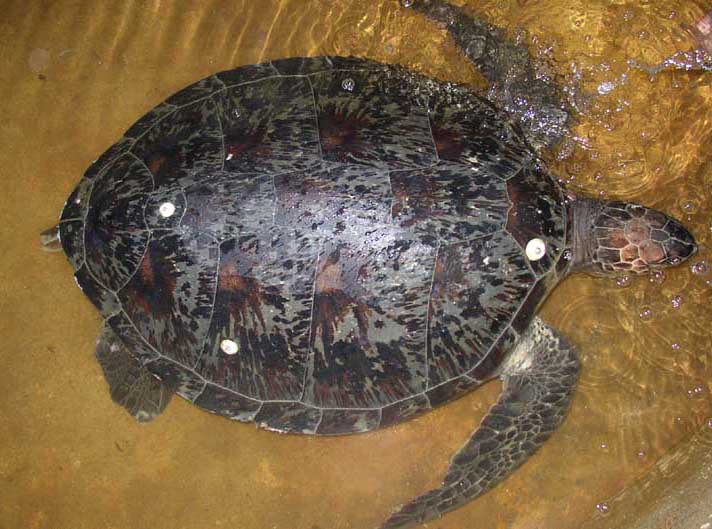 A
live
Green Turtle, Chelonia
mydas, was landed on the west coast of
Guernsey (Channel Islands) in the afternoon.
A
live
Green Turtle, Chelonia
mydas, was landed on the west coast of
Guernsey (Channel Islands) in the afternoon.
Geoff
George and Yvonne Chauvel discovered the turtle
on Saline Beach. The Green Turtle has been treated by the States of Guernsey
veterinarian and transferred to the Guernsey
Aquarium at St. Peter Port.
The white spots are a species of turtle barnacle, which may have not been recorded before on the British list of marine (barnacle) species (MCS Directory). It could be the species Chelonibia testudinaria, but this is only an educated guess.
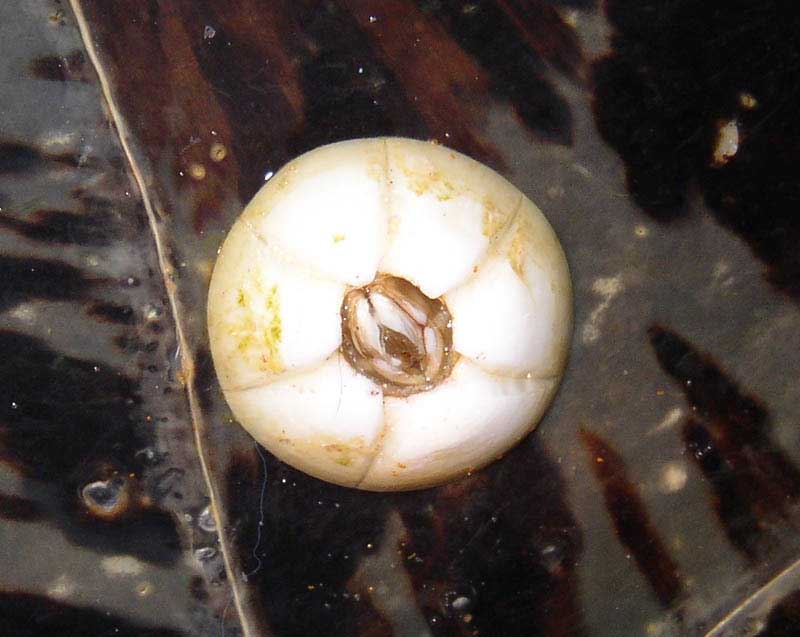
11
December 2002
Taking
up this theme of the wildlife that surrounds us, but which is terra incognito
to most of us amateur naturalists, Barry Collins
(wildlife warden for Thorney Island) contributes
an apt example from his observation of a marker post recently washed up
on the Pilsey Sands in Chichester Harbour, Sussex. The section of the post
which had for years been under water was covered with a thousand
Goose
Barnacles, Lepas anatifera, looking like silvery grey
mussel
shells around 5 cm (2 inches) long, each attached to the post by a long
flexible brown stem which may be 20 cm (8 inches) long allowing the living
crustacean to reach out into the surrounding water to feed.
19
June 2002
Goose
Barnacles, Lepas anatifera, are washed up on a plank at Borth-y-Gêst,
near Porthmadog, north Wales (Tremadoc Bay, north bit of Cardigan Bay),
and these attracted the curiosity of the public.
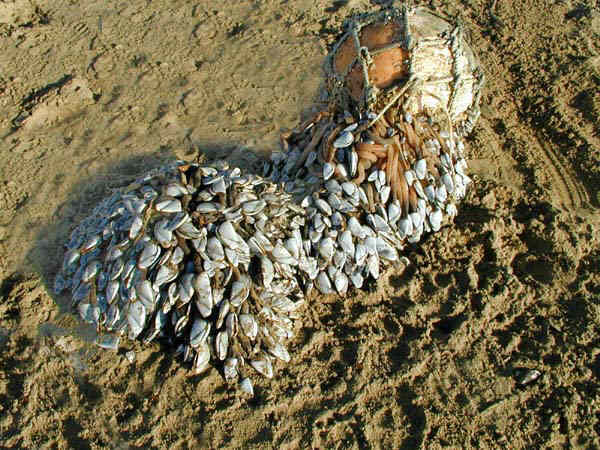
Stella
Turk
This message has been passed
on from the Cornish
Mailing List
12
September 2000
Thought you would be interested
in this feedback of this morning: Anna and Peter Mason of 36 Primrose Way,
Seaton, Devon spotted our Goose Barnacles in the Centre and on realising
what they were dashed off to retrieve some more they had seen on Seaton
Beach this morning (11 am). They have been put in one of our tanks, but
we have to date never seen so
many on one buoy (see attached
photo). Most are in good condition and are now filtering. (We have managed
to feed the others by hand with half a cockle - this is going to take forever!)
We have had SW prevailing
winds all week after the huge gales. We estimate there are 300 barnacles
on the buoy and this is not a recognised British type fender, as noted
before. Tiny barnacles are also present.
Best Wishes
Jenny
Sea Discovery Centre-Axmouth
12
September 2000

September
2000
Goose
Barnacles,
Lepas anatifera, were washed up between Seaton and
Axmouth, in Lyme Bay, Dorset, on fenders from an American boat, so they
may have drifted all the way across the Atlantic Ocean.
Hi
Andy,
We
get Goose Barnacles (Lepas anatifera) washing in on drift
regularly, and a week or two back we found several score Buoy
Barnacles (Lepas fascicularis) washed in at Porthcothan, Cornwall
WT has the details)
Best
Wishes,
Nick
Darke
Date: Tue, 3 Oct 2000
10:03:39 +0100
From: "nick
darke" <lobsterman@ukonline.co.uk>
Subject: Portuguese Men
o'War etc.
Hi Vince,
Just to report two Portuguese
Men o'War at Watergate & Mawgan Porth (one on each beach) today
3/10/00
Also, a Manx Shearwater, dead, clean, fresh, Watergate 3/10/00
Also, many Buoy Barnacles, and literally thousands of By-the-wind Sailors Velella, on Porthcothan but none on Watergate and Mawgan Porth. I've always thought of these as predominantly south-westerly strandings, Porthcothan is a NW facing beach, and our recent gale was NW.
Nick Darke
Report
on Vince
Smith's One-List/Cornish Wildlife
I have not heard of any Goose
Barnacles being washed up lately, but you may be interested to know that
I found a single specimen of Pollicipes pollicipes below
the cliff at Carn Les Boel near Land's End SW 356232, several years ago,
I understood at the time that the last previous sighting on this side of
the channel was in 1880. I am in no condition to climb down there now,
so do not know if there are any there at this time. I could e-mail
you a picture of it that I took so many years ago
if you are interested,
Ray
Dennis
Still in Isles of Scilly mode I'm afraid!
We
saw a fair few Goose Barnacles washed up on the sandbar between St. Agnes
and Gugh.
On Perranporth Beach, Cornwall, Paul Gainey found a large coconut, still with its outer husk, as well as Buoy Barnacles (Lepas fascicularis) and By-the-Wind Sailors (Velella velella).
Stella Turk
Report
on Vince
Smith's One-List/Cornish Wildlife
These Cornish Environmental
eForum pages contain many Goose and Buoy Barnacle reports.
See also:
Cornish
Marine Life Records (Ray Dennis) 1999
Chthamalus
stellatus
Chthamalus
montagui
Semibalanus
balanoides
Elminius
modestus
Balanus
crenatus
Balanus
improvisus
Balanus
perforatus
|
|
|
|
|
|
|
|
|
|
|
|
|
|
|
|
|
|
|
|
|
|
|
|
|
|
|
|
|
|
|
|
|
|
|
|
|
|
|
|
|
|
|
|
|
|
|
|
|
|
|
|
|
|
|
|
|
|
|
|
|
|
|
|
|
|
|
|
|
|
|
|
|
|
|
|
|
|
|
Chthamalus
stellatus (Poli, 1791)
|
|
|
|
|
|
|
|
|
|
|
|
|
|
|
|
|
|
See O"Riordan (1979).
|
|
|
|
|
|
See Smaldon &
Lyster (1976).
|
|
|
|
|
|
|
|
|
|
|
|
|
|
|
|
|
|
|
|
|
|
|
|
|
|
|
|
|
|
|
|
|
|
|
|
|
|
|
|
|
|
|
See Southward (1995).
|
|
|
|
|
|
|
|
|
|
|
|
|
|
|
|
|
|
|
|
|
|
|
|
|
|
|
|
|
|
|
| Balanus amphitrite | |
| Balanus perforatus |
|
|
|
|
|
|
|
|
Parasitic barnacle Sacculina
carcini
Barnacles for Dinner discussion
Crustacean EBiota of Cetaceans (notes only)
Barnacles become toxic to repel hungry predators
| FIVE KINGDOMS
TAXONOMIC INDEX TO BRITISH MARINE WILDLIFE
Use these links if your are familiar with the scientific classifications of marine life |
|
|
|
|
|
News 2018 |
Membership Form |
|